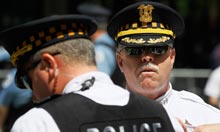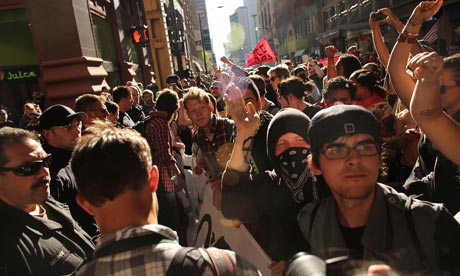Despite occasional violent clashes, weekend protests were largely free of the large-scale confrontations seen in other cities
Even as thousands of people demonstrated, there were no arrests on the same scale as seen in other cities over previous months. Photograph: Spencer Platt/Getty Images
A decision by police in Chicago to let protesters roam the streets of the city during the Nato summit, in stark contrast to heavy-handed tactics elsewhere in the US, appears to have been the key to avoiding a repeat of the disastrous 1968 riots that led to the city being struck off the international political circuit for a generation.
Despite the presence of thousands of anti-Nato protesters, there was no rerun of the pitched battles that marred the World Trade Organisation summit in Seattle. While some clashes occurred between police and protesters on Sunday, the week of demonstrations largely avoided repeating the ugly scenes that have accompanied Occupy demonstrations in New York, Oakland and other US cities.
Protest organisers said up to 15,000 people took to the streets on Sunday, disputing Chicago police's estimate of 2,500 demonstrators. The march was led by a group of around 20 Iraq war veterans, aiming to return their service medals to the leaders and delegates meeting at the summit.
Throughout the week, Chicago police officials appeared to have taken a deliberate decision to avoid confrontation. Even as thousands of people demonstrated just blocks away from McCormick place on Sunday, where 51 world leaders were meeting, there were no arrests on the same scale as seen in other cities over previous months. There were some clashes at the very front of the action, as black bloc activists pushed towards a police line with its back to the conference centre, but tear gas was not deployed and protesters' vinegar-soaked bandanas were not required.
Demonstrations also took place at Barack Obama's campaign headquarters; the house of Chicago's mayor, Rahm Emanuel; the Canadian consulate and Boeing's offices, and all largely without incident.
For most of the weekend, Chicago police superintendent Garry McCarthy was on the ground, walking to the rear of his officers as they policed the various demonstration. He said it was a deliberate strategy to allow protesters to "exercise their right to the first amendment", adding that they were free to march where they chose "as long as they don't engage in any criminal activity".
 Police superintendent Garry McCarthy. Photograph: Charles Rex Arbogast/AP"That's his style," a white-shirted police officer told the Guardian as McCarthy walked away. "He's studied how other cities have done things. It's his leadership."
Police superintendent Garry McCarthy. Photograph: Charles Rex Arbogast/AP"That's his style," a white-shirted police officer told the Guardian as McCarthy walked away. "He's studied how other cities have done things. It's his leadership."The arrests that dominated much of the media's coverage came covertly, miles from the centre of the city, when three protesters were arrested at a Bridgeport apartment late on Wednesday night.
Jared Chase, 24, from New Hampshire, and Floridians Brian Church, 20, and Brent Vincent Betterly, 24, were charged on Friday with conspiracy to commit terrorism, providing material support for terrorism and possession of an explosive or incendiary device. Two days later, Mark Neiweem, 28, was in court over charges of possessing explosives or incendiary devices, and Sebastian Senakiewicz, 24, was charged with making a terrorist threat.
The first three arrests came after Chicago police had embedded undercover officers – "Nadia", "Mo" and "Gloves" – with the first three men, allegedly witnessing the accused making Molotov cocktails and planning to target a police station. Mo and Gloves are reportedly a common thread among the five charged, with the defence attorney for Chase, Church and Betterly accusing police of "entrapment to the highest degree" and having "egged on" the suspects.
But during the street demonstrations in Chicago, police were largely content to sit back and allow protesters to roam where they wished, in a significant departure from tactics witnessed in New York, Oakland and elsewhere over the past eight months.
One of the first large Occupy Wall Street marches infamously ended with 700 people, including journalists, handcuffed and arrested on the Brooklyn Bridge. In Oakland, police repeatedly used tear gas and rubber bullets to prevent protesters occupying certain parts of streets or parks, seriously injuring Iraq war veteran Scott Olsen in the process.
In Chicago, the police strategy was largely to allow protesters to go wherever they chose. On Thursday, after a National Nurses United demonstration at Daley place in Chicago, several hundred protesters took off on an impromptu and unpermitted march. As they ran down the centre of the street, police on bicycles appeared at one intersection, blocking protesters' progress.
"Whose streets? Our streets," protesters chanted. After around two minutes, the police line split, and marchers surged forward along the street, to cries of "this is what democracy looks like". The police strategy – seemingly happy to slow down the marchers, before ultimately allowing them to continue in whichever way they chose – was repeated again and again into the night, and furthermore on Friday.
Although the smaller demonstrations on Thursday, Friday and Saturday were allowed this freedom, protesters were critical of the Chicago police's handling of the end of Sunday's main anti-war march, when several protesters were injured in what one organizer described as "totally deplorable" clashes.
 Police clash with demonstrators on Sunday. Photograph: Scott Olson/Getty ImagesProtesters had secured a permit for the march, and it was rigidly enforced, with officers lining the route, preventing any of the splintering that had been embraced in previous days. When the demonstration officially ended at 4pm, when around 20 Iraq war veterans clambered onto a flatbed trailer two blocks west of McCormick place to return the medals they had been awarded for their part in the conflict. Scott Olsen, who was struck in the head, allegedly by a police projectile, as officers attempted to clear out Occupy Oakland's camp in October, was among those who hurled the decorations towards the summit.
Police clash with demonstrators on Sunday. Photograph: Scott Olson/Getty ImagesProtesters had secured a permit for the march, and it was rigidly enforced, with officers lining the route, preventing any of the splintering that had been embraced in previous days. When the demonstration officially ended at 4pm, when around 20 Iraq war veterans clambered onto a flatbed trailer two blocks west of McCormick place to return the medals they had been awarded for their part in the conflict. Scott Olsen, who was struck in the head, allegedly by a police projectile, as officers attempted to clear out Occupy Oakland's camp in October, was among those who hurled the decorations towards the summit."They're tokens designed to make us feel good/rewarded for participating in fighting for the 1%, oppressing whole populations, and sending our world into a downward spiral," Olsen had told the Guardian before throwing away his global war on terror service, OIF campaign, national defense service and marine corps good conduct medals.
"They're meaningless to me," he added.
The ceremony was meant to have marked the end of the march, which police estimated was attended by around 2,500 people but organisers said was closer to 15,000. However, as the veterans left the makeshift stage, black bloc activists were expressing displeasure at not being allowed to get nearer to McCormick place.
Around 30 protesters, clad in black with bandanas or masks covering their faces, pushed forward through the mostly peaceful crowd towards McCormick place. Chicago police may have allowed demonstrations the freedom of the streets further north, but they were unwilling to allow protesters any nearer to the Nato summit, and attempted to force back the crowd.
In the ensuing melee, police used baton strikes to push back protesters, with several people taken away bleeding from injuries. There was also violence towards police, with a few members of the crowd tossing plastic bottles and sticks from protest signs towards officers.
Occupy Chicago condemned the violence as "unprecedented brutality". Spokeswoman Rachael Perrotta said she had "spent the afternoon driving injured protesters from the demonstration to the Chicago action medical wellness centre". Andy Thayer, an organiser with a coalition of groups opposed to Nato and the G8, told the Guardian the veterans' protest against the war in Iraq had been "profound", but that the police action after that had been "totally deplorable".
"They very aggressively marched in and were pushing and shoving people," Thayer said. Put to him that the black bloc had exacerbated the action, Thayer said he was not "going to trash talk black bloc or any other protesters here".
"We've got to remember just 24 hours before, the police nearly committed vehicular homicide by accelerating a police van into a protester, sending him to hospital," he said, referring to an incident on Saturday night, when a demonstrator was allegedly struck by a police vehicle as it passed through a crowd of protesters. Reports suggested the individual was taken to hospital but not kept overnight.
Eight police officers were injured on Sunday, said McCarthy, who told the local ABC affiliate his officers had done "a great job".
"The cops know, and they're hearing it, not only from me, but certainly from the public, that they've done an outstanding job. I think they're very proud of this event. They realize this is a historic event and they're all taking part of it," McCarthy said.
http://www.guardian.co.uk/world/2012/may/22/chicago-police-anti-nato-demonstrations

No comments:
Post a Comment